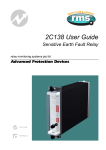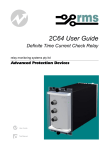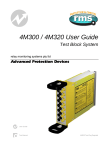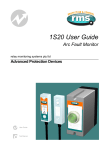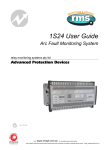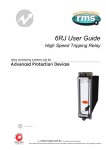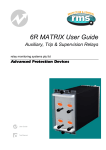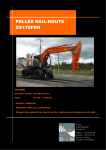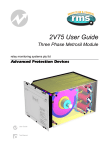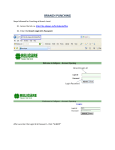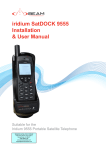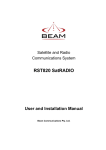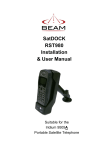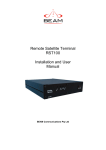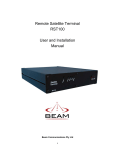Download 2C73 User's Guide
Transcript
2T105 User Guide Multi Range Precision Time Delay Relay relay monitoring systems pty ltd Advanced Protection Devices User Guide Test Manual 2T105 User Guide About This Manual This User Guide covers all 2T105 relays manufactured from May 2006. Earlier relays do not necessarily incorporate all the features described. Our policy of continuous may means that extra features & functionality may have been added. The 2T105 User Guide is designed as a generic document to describe the common operating parameters for all relays built on this platform. Some relay applications are described but for specific model information the individual “K” number Product / Test manuals should be consulted. The copyright and other intellectual property rights in this document, and in any model or article produced from it (and including any Registered or unregistered design rights) are the property of Relay Monitoring Systems Pty Ltd. No part of this document shall be reproduced or modified or stored in another form, in any data retrieval system, without the permission of Relay Monitoring Systems Pty Ltd, nor shall any model or article be reproduced from this document without consent from Relay Monitoring Systems Pty Ltd. While the information and guidance given in this document is believed to be correct, no liability shall be accepted for any loss or damage caused by any error or omission, whether such error or omission is the result of negligence or any other cause. Any and all such liability is disclaimed. Contact Us © Relay Monitoring Systems Pty Ltd 2006-2008 6 Anzed Court • Mulgrave 3170 • AUSTRALIA Phone 61 3 9561 0266 • Fax 61 3 9561 0277 Email [email protected] • Web www.rmspl.com.au To download a PDF version of this guide: http://www.rmspl.com.au/userguide/2t105_user_guide.pdf To download the model specific Test Manual: http://www.rmspl.com.au/search.asp How this guide is organised This guide is divided into five parts: Part 1 Overview About this Manual Contents Test Manual Part 2 Mechanical Configuration Part 3 Technical Bulletin Part 4 Installation Handling of Electronic Equipment Safety Unpacking Accessories Storage & Handling Equipment Operating Conditions Relay Dimensions & Other Mounting Accessories Equipment Connections Commissioning Decommissioning & Disposal Part 5 Maintenance Mechanical Inspection Test Intervals Defect Report Form Visit www.rmspl.com.au for the latest product information. Due to RMS continuous product improvement policy this information is subject to change without notice. 2T105_Guide/Iss A/29/10/08 Part 1 Test Manual This User Guide covers all 2T105 relay versions & describes the generic features & attributes common across all versions. Different relay versions are required to cater for varying customer requirements such as auxiliary voltage range, I/O configuration, case style, relay functionality etc. The product ordering code described in the Technical Bulletin is used to generate a unique version of the relay specification & is called a type number. The type number takes the form 2T105Kxx where the Kxx is the “K” or version number. www.rmspl.com.au/handbook/parta3.pdf Refer to: for a complete description of the RMS “K” number system. Each 2T105 version has a specific Test Manual which provides details on the unique attributes of the relay. Each Test Manual includes the following information: • Test Certificate • Specific technical variations from the standard model if applicable • Test & calibration record • Wiring diagram A Test Manual is provided with each relay shipped. If you require a copy of the Test Manual for an RMS product the following options are available: • Check the RMS web site at: www.rmspl.com.au/search.asp • RMS CD catalogue select: List all Product/Test Manuals under Technical Library • Contact RMS or a representative & request a hard copy or PDF by email. Visit www.rmspl.com.au for the latest product information. Due to RMS continuous product improvement policy this information is subject to change without notice. 2T105_Guide/Iss A/29/10/08 Part 2 Mechanical Configuration Great care has been taken to design a rugged, cost effective & flexible mechanical solution for the MATRIX range of RMS protection relays. The MATRIX range provides a compact draw out case solution with M4 screw terminals: • • • 2M28 4M28 4M56 Size 2 with 28 terminals Size 4 with 28 terminals Size 4 with 56 terminals Complete details & attributes for the M (MATRIX) cases & accessories may be found at: http://www.rmspl.com.au/mseries.htm The 2T105 is configured in a 2M28 case & the following photographs depict the general mechanical configuration. It should be noted that re-usable JIS plastic threading (PT type) screws are used to bind the draw out relay module. Mechanical flag trip indication Visit Non volatile LED flag trip indication www.rmspl.com.au for the latest product information. Due to RMS continuous product improvement policy this information is subject to change without notice. 2T105_Guide/Iss A/29/10/08 2T105 relay assembly depicted in a 2M28 case Visit www.rmspl.com.au for the latest product information. Due to RMS continuous product improvement policy this information is subject to change without notice. 2T105_Guide/Iss A/29/10/08 Part 3 Technical Bulletin The detailed technical attributes, functional description & performance specifications for the 2T105 are described in the attached Technical Bulletin. For the most up to date version go to: www.rmspl.com.au/handbook/2t105.htm For any specific attributes of a particular version refer to the Test Manual for that type (K) number. The order of precedence for technical information is as follows: • • • Test Manual Technical Bulletin User Guide Visit www.rmspl.com.au for the latest product information. Due to RMS continuous product improvement policy this information is subject to change without notice. 2T105_Guide/Iss A/29/10/08 2T105 Technical Bulletin Multi Range Digital Setting Time Delay Relay Features Four time ranges 0-0.99s, 0-9.9s, 0-99s, 0-990s High accuracy & repeatability – timing compensated for output relay delay Time settings easily selected by digital thumb wheel switches Selectable delay operate or delay release Optional reset functions Instantaneous (Fast), definite time, count down 4 C/O output contacts Wide auxiliary supply range with fail alarm contact Timing in progress LED Non-volatile trip indication Multi voltage timer initiate input Multi voltage flag reset input Size 2M draw out case Application The 2T105 time delay relay is particularly suitable for use in protection & control schemes where precision time delays are required. CB FAIL A typical use is for providing a definite time delay in circuit breaker failure protection. For example: The transformer multi-trip relays energize the 2T105 timer & if the circuit breaker (CB) fails to clear the fault within the pre-set (0.6s) the timer times out & operates a multi-trip relay. This in turn trips all CB’s on the section of the busbar connected to the CB, which has failed to trip. INDUCTION DISC RESET EMULATION Replacement of induction disc timing elements with solid-state relays can result in a loss of grading & reduced functionality due to the different reset characteristics. For example, the inherent slow reset time of induction disc relays provide an advantage in sensitive overcurrent schemes where pecking faults could go undetected due to the timer being instantaneously reset each time the current momentarily falls bellow the start setting. The 2T105 may be specified with a number of reset functions to avoid this problem & to suit specific protection applications. 2T105 depicted in a 2M28 case. Operation Made in Australia A crystal oscillator & embedded micro controller based timing circuit are employed to provide accurate timing & flexible functionality. When a control signal is applied to the timer initiate input, a counter begins counting down from the thumb wheel switch setting. When the zero is detected, the output relay contacts & flag operate. Three time ranges are selected via a front panel switch. An internal configuration switch can be used to select a x10 range multiplier to provide up to 990s of precision time delay. Two timing modes are available: Time delay ON mode (Relay starts timing after the initiate control signal is applied & output contact picks up after the pre-set time delay has elapsed) or; Time delay OFF mode (Relay output contact picks up instantaneously when the initiate control signal is applied, starts timing after the initiate control signal is removed & drops out after the pre-set time delay has elapsed). An amber LED on the front panel indicates when the relay has been initiated & flashes during timing. The 2T105 timer may be specified with a number of different reset functions to provide instantaneous reset, definite time reset or induction dist reset emulation. These functions are specified at time of order. A switchmode power supply provides a very wide auxiliary operating range. A relay fail alarm is provided in the form of a C/O contact which is picked up when the auxiliary supply rail & CPU watchdog status is healthy. www.rmspl.com.au Visit for the latest product information. Due to RMS continuous product improvement policy this information is subject to change without notice. 2T105/Iss K/12/10/09 - 1/5 Timing Functions TIMING FUNCTION / INITIATE SIGNAL INPUT (Status input ) For accurate timing functions the 2T105 detects application or removal of an external voltage control signal. This mode is set using internal configuration switch 2 (Refer order code details). Refer to Table 2 for timing initiate P/U & D/O times. DELAY OPERATE TIMING FUNCTION This timing mode is selected using internal configuration switch 3. The relay is permanently connected to the auxiliary supply & is initiated by the application of a control signal. Application of the initiate signal starts the pre set timing cycle. During timing the front panel initiate LED will flash & then go on solid once the thumbwheel time setting has elapsed, this sets the output relay & visual indicator. The initiate LED is extinguished & the output contacts reset when the initiate signal is removed. After system reset the visual indicator may be reset locally using the front panel push button or remotely via the flag reset input. DELAY RELEASE TIMING FUNCTION This timing mode is selected using internal configuration switch 3. The relay is permanently connected to the auxiliary supply. Application of the initiate control signal, causes the output relay to set instantaneously (Rset). It will remain in this state until the control signal is removed; this starts the timing cycle & resets the output relay when the preset time delay is reached. Delay Release (OFF) Flag reset Flag To achieve a simple but less accurate delay ON function, the initiate signal may be connected directly to the auxiliary supply. Timing will then commence when power is applied to the relay while removal of power will reset the time delay & output relay. This mode is only suitable for longer time delay settings as the switch mode power supply takes 100 – 500ms (Depending on Vx), to start which adds to the inherent time delay. Delay Operate (ON) Flag reset Flag Initiate Contacts + 0 Initiate Contacts + 20ms min reset pulse 0 P/U D/O + 0 P/U D/O P/U D/O t Set r Set t Re-application of the initiate signal during timing will reset the time delay (Refer timing reset options). After time out the contacts are reset to the P/U condition. The flag can be reset at any time, except during timing. 20ms min reset pulse TIMING RESET OPTIONS Instantaneous If reset before the preset time delay is reached the timing element will reset (D/O) as per Table 2. P/U D/O + P/U 0 t P/U t D/O Definite Time Reset (Treset) If reset before the preset time delay is reached the delay timer will pause until the reset time has elapsed before resetting. If the timer is re-initiated before the reset time has elapsed, the delay timer will restart the timing sequence from the paused timing point. D/O Set AC Set DC t Removal of the initiate signal during timing will reset the time delay (Refer timing reset options). After time out the contacts are reset to the D/O condition upon removal of the initiate signal. The flag can be reset provided the timer initiate signal is removed. Count Down Reset If reset before the preset time delay is reached, the timer will count down toward reset. If the timer is re-initiated before reset is reached the timer will start counting back up towards the time delay pre set. RESET FUNCTION DIAGRAM www.rmspl.com.au Visit for the latest product information. Due to RMS continuous product improvement policy this information is subject to change without notice. 2T105/Iss K/12/10/09 - 2/5 Technical Data AUXILIARY SUPPLY 40-300V DC & 40-275V AC or 20-70V DC switchmode supply. BURDEN (110V DC nominal supply) Less than 2 watts during idle & timing. Less than 4 watts when output relays are energized. CONFIGURATION SWITCHES Configuration switches are accessible to the user & can be set by withdrawing the relay module & following the instructions on the side plate label. A bank of 5 switches are provided as depicted below & are read each time the 2T105 is powered up: Configuration Switches RELAY FAIL ALARM A C/O alarm contact is maintained in the energized state when all of the following conditions are met: The auxiliary supply is applied The internal 24V DC rail is within acceptable limits The CPU hardware watchdog maintains a pulsing output A CPU software watchdog records “suspect” events to an assert register & if necessary performs a soft restart. TIME SETTING RANGES The 2T105 relay allows for precision time settings of between zero (Minimum operate time) & 990 seconds. This is achieved by the use of two decimal thumb wheel switches & a range multiplication switch on the front panel. A 10x setting multiplier is activated when configuration switch 5 is set to OFF to extend timer range 3 up to 990s. Range Selector Setting Achievable Time Setting Range Range 1 Range 2 Range 3 Range setting x10 Zero to 0.99 Zero to 9.9 Zero to 99 Zero to 990 Resolution of Time Setting Sec Sec Sec Sec 0.01 Sec 0.1 Sec 1 Sec 10 Sec Table 1 TIME DELAY SETTING CHANGES The time delay & function settings should only be changed when the timing initiate LED is extinguished. Time delay settings are read at the beginning of each timing sequence. TIMER INITIATE STATUS INPUT DELAY Initiate input DC AC Minimum P/U D/O P/U D/O AC Rejection Filter ON OFF <16ms <4ms <4ms <16ms <23ms N/A <33ms Table 2 3 4 5 STATUS INPUT OPERATING VOLTAGE (AC rejection filter) The operating range of the status inputs are set using internal configuration switch 1. This setting may be pre defined when ordering. 18 - 300V DC Set Configuration Switch to ON In this mode the universal status input will reject AC signals that may be induced on the control wiring. Suitable for high security applications where a DC battery supply is available. 18 - 300V DC & 18 – 275V AC Set Configuration Switch to OFF In this mode the universal status input is designed to operate on both AC & DC input voltages. Suitable for applications where an AC auxiliary voltage is available such as transformer or generator control panels. STATUS INPUT MINIMUM OPERATING CURRENT 10mA P/U for 1ms then reducing to1.5mA after 4ms. While the function of the configuration switches may vary for special custom models, the standard functions & default settings are described in the Ordering Information section. FRONT PANEL INDICATORS Four LED indicators are provided on the front panel: Power On solid when auxiliary supply healthy Timing Flashing during timing Trip On solid when output relay operated Range x10 On when the x10 time range selected Green Amber Red Green A hand & remote reset magnetic disc flag (permanent memory) indicator may be specified as an option. Note that an auxiliary supply is required to reset the flag circuits. TRANSIENT OVERVOLTAGE Between all terminals & earth Between independent circuits without damage or flashover 2T105 time delay setting Time delay The minimum output contact operate time is equal to the timer initiate status input delays in Table 2 + 6ms. Time delay settings ≤ to this figure will result in a relay contact operate time equal to the minimum. TIMING ACCURACY Maximum timing error as a % of setting + uncertainty in ms. Initiate input DC AC 2 The trip LED status is stored in non volatile memory & will be restored when the 2T105 is powered up after loss of the auxiliary supply. The preserved trip LED state is reset using the front panel flag reset button or status input. MINIMUM OUTPUT CONTACT OPERATE TIME Minimum 1 AC Rejection Filter ON OFF -0.19% +0.2ms N/A -0.19% +10ms Table 3 IEC60255-5 CLASS III 5kV 1.2/50us 0.5J 5kV 1.2/50us 0.5J INSULATION COORDINATION Between all terminals & earth Between independent circuits Across normally open contacts IEC60255-5 CLASS III 2.0kV RMS for 1 minute 2.0kV RMS for 1 minute 1.0kV RMS for 1 minute AUXILIARY SUPPLY Allowable breaks / dips in supply Collapse to zero from nominal voltage ≤ 20ms IEC60255-11 HIGH FREQUENCY DISTURBANCE 2.5kV 1MHz common mode 1.0kV 1MHz differential mode IEC60255-22-1 CLASS III ELECTROSTATIC DISCHARGE 6kV contact discharge IEC60255-22-2 CLASS III ≤ 5% variation ≤ 3% variation FAST TRANSIENT 4kV, 5/50ns, 100KHz repetitive IEC60255-22-4 ≤ 3% variation TEMPERATURE RANGE Operating: Storage: IEC68-2-1/2 o -10 to +55 C o -25 to +75 C HUMIDITY o 40 C & 95% RH non condensing www.rmspl.com.au IEC68-2-78 Visit for the latest product information. Due to RMS continuous product improvement policy this information is subject to change without notice. 2T105/Iss K/12/10/09 - 3/5 Wiring Diagram OUTPUT RELAY CONTACT CONFIGURATION 4 C/O contacts OUTPUT CONTACT DWELL TIME Once operated all time delayed output contacts have a minimum dwell time of 100ms. OUTPUT CONTACT RATINGS IEC60255-0-2 Carry continuously 5A AC or DC Make & carry 0.5s 20A AC or DC L/R ≤ 40ms & V ≤ 300V 0.2s 30A AC or DC AC resistive 1,250VA Break capacity AC inductive 250VA @ PF ≤ 0.4 I ≤ 5A & V ≤ 300V DC resistive 75W 30W @ L/R ≤ 40ms DC inductive 50W @ L/R ≤ 10ms 6 Minimum number of operations 10 at maximum load Minimum recommended load 0.5W limit 10mA / 5V Vx 1 25 3 23 27 Fail Healthy Alarm common 11 5 Timer initiate SI1 13 7 Output 1 15 17 Remote flag reset SI2 9 19 10 21 Output 2 12 14 Output 3 16 18 20 Output 4 22 2 2T105 wiring diagram - Relay shown in de-energised condition Size 2M28-S draw out case Drawing units: mm Indicative position 1 2 27 28 14 Suits flush panel mounting & 4U high 19 inch rack frame Front view 15 2 holes of 3.7 Side view www.rmspl.com.au Terminal layout Panel cut out Visit for the latest product information. Due to RMS continuous product improvement policy this information is subject to change without notice. 2T105/Iss K/12/10/09 - 4/5 Ordering Information CASE Size 2M28-S draw out case 28 M4 screw terminals Flush panel mount or 4U high 1/8 width 19 inch rack mount ORDER CODE The order code determines the production build in the factory & cannot be changed in the field. Generate the required order code as follows: e.g. 2T105-BAA ACCESSORIES SUPPLIED WITH EACH RELAY 1 x M4 self threading mounting screw kit P/N 290-406-151 1 x M4 terminal screw kit P/N 290-407-153 1 x Product Test Manual Order Code General Type 2T105 1 2 3 - 1 AUXILIARY SUPPLY RANGE A B 20-70V DC 40-275V AC & 40-300V DC 2 TIMING RESET FUNCTION A B C Instantaneous reset Definite time reset – Treset ____ s Specify a Treset delay in the range 0.1 to 255s in 0.1s steps Count down reset 3 TRIP FLAG A B Red LED non volatile trip indication Magnetic disc trip flag (Standard) CONFIGURATION CODE (Optional specification) The configuration code can be set in the field by withdrawing the relay module & following the instructions on the side plate label. The configuration code may be specified at time of order so that the relay will be shipped from the factory pre-set to meet customer requirements. e.g. CONFIG-01011 If a configuration code is not specified the factory default will be set as indicated below. i.e. CONFIG-11111 Configuration Switches Specify factory Configuration CONFIG 1 2 4 5 - 1 STATUS INPUT OPERATION 1 0 ON OFF DC operation only - AC rejection ON AC / DC operation - AC rejection OFF 2 TIMER INITIATE INPUT 1 0 ON OFF Apply volts to initiate Remove volts to initiate 3 TIME DELAY FUNCTION 1 0 ON OFF Time delay OPERATE Time delay RELEASE 4 OUTPUT RELAY FUNCTION 1 0 ON OFF 5 TIME RANGE MULTIPLIER 1 0 ON OFF www.rmspl.com.au 3 (Default) (Default) (Default) All outputs contacts are time delayed (Default) Output contact 4 will operate instantaneously irrespective of the front panel time delay settings. Selected time range x1 Selected time range x10 (Default) Visit for the latest product information. Due to RMS continuous product improvement policy this information is subject to change without notice. 2T105/Iss K/12/10/09 - 5/5 Part 4 Installation Handling of Electronic Equipment A person’s normal movements can easily generate electrostatic potentials of several thousand volts. Discharge of these voltages into semiconductor devices when handling electronic circuits can cause serious damage, which often may not be immediately apparent but the reliability of the circuit will have been reduced. The electronic circuits of Relay Monitoring Systems Pty Ltd products are immune to the relevant levels of electrostatic discharge when housed in the case. Do not expose them to the risk of damage by withdrawing modules unnecessarily. Each module incorporates the highest practicable protection for its semiconductor devices. However, if it becomes necessary to withdraw a module, the following precautions should be taken to preserve the high reliability and long life for which the equipment has been designed and manufactured. 1. Before removing a module, ensure that you are at the same electrostatic potential as the equipment by touching the case. 2. Handle the module by its front-plate, frame, or edges of the printed circuit board. 3. Avoid touching the electronic components, printed circuit track or connectors. 4. Do not pass the module to any person without first ensuring that you are both at the same electrostatic potential. Shaking hands achieves equipotential. 5. Place the module on an antistatic surface, or on a conducting surface which is at the same potential as yourself. 6. Store or transport the module in a conductive bag. If you are making measurements on the internal electronic circuitry of an equipment in service, it is preferable that you are earthed to the case with a conductive wrist strap. Wrist straps should have a resistance to ground between 500k – 10M ohms. If a wrist strap is not available, you should maintain regular contact with the case to prevent the build up of static. Instrumentation which may be used for making measurements should be earthed to the case whenever possible. Visit www.rmspl.com.au for the latest product information. Due to RMS continuous product improvement policy this information is subject to change without notice. User_Guide-5/IssE/25/08/08 Safety Section This Safety Section should be read before commencing any work on the equipment. The information in the Safety Section of the product documentation is intended to ensure that products are properly installed and handled in order to maintain them in a safe condition. It is assumed that everyone who will be associated with the equipment will be familiar with the contents of the Safety Section. Explanation of Symbols & Labels The meaning of symbols and labels which may be used on the equipment or in the product documentation, is given below. Caution: refer to product information Caution: risk of electric shock ! Functional earth terminal Note: this symbol may also be used for a protective/safety earth terminal if that terminal is part of a terminal block or sub-assembly eg. power supply. Visit www.rmspl.com.au for the latest product information. Due to RMS continuous product improvement policy this information is subject to change without notice. User_Guide-4/Iss E/25/08/08 Unpacking Upon receipt inspect the outer shipping carton or pallet for obvious damage. Remove the individually packaged relays and inspect the cartons for obvious damage. To prevent the possible ingress of dirt the carton should not be opened until the relay is to be used. Refer to the following images for unpacking the relay: Outer packing carton showing shipping documentation pouch. Address label on top of carton. Inner packing carton showing front label detailing the customer name, order number, relay part number & description, the relay job number & packing date. (Size 2 inner packing carton depicted) Visit www.rmspl.com.au for the latest product information. Due to RMS continuous product improvement policy this information is subject to change without notice. User_Guide-4/Iss E/25/08/08 Unpacking (Continued) Inner packing carton with lid open showing protective foam insert. CD depicted supplied with digital relay models or upon request at time of order. Inner packing carton with protective foam insert removed showing relay location. Where mechanical flags are fitted the yellow transit wedge must be removed before operation using a gentle twisting action. The wedge should be stored with the original packaging material. Visit www.rmspl.com.au for the latest product information. Due to RMS continuous product improvement policy this information is subject to change without notice. User_Guide-4/Iss E/25/08/08 Relay Module Side Label Depicting Product Details Relay Module Side Label Depicting Wiring Diagram Visit www.rmspl.com.au (6R MATRIX relays only) for the latest product information. Due to RMS continuous product improvement policy this information is subject to change without notice. User_Guide-4/Iss E/25/08/08 Accessories Supplied With Each Relay Self threading M4 mounting screws M4 terminal screws with captured lock washers Storage & Handling If damage has been sustained a claim should immediately be made against the carrier, also inform Relay Monitoring Systems Pty Ltd and the nearest RMS agent When not required for immediate use, the relay should be returned to its original carton and stored in a clean, dry place. Relays which have been removed from their cases should not be left in situations where they are exposed to dust or damp. This particularly applies to installations which are being carried out at the same time as constructional work. If relays are not installed immediately upon receipt they should be stored in a place free from dust and moisture in their original cartons. Dust which collects on a carton may, on subsequent unpacking, find its ay into the relay; in damp conditions the carton and packing may become impregnated with moisture and the dehumidifying agent will lose is efficiency. Visit www.rmspl.com.au for the latest product information. Due to RMS continuous product improvement policy this information is subject to change without notice. User_Guide-4/Iss E/25/08/08 Equipment Operating Conditions The equipment should be operated within the specified electrical and environmental limits. Protective relays, although generally of robust construction, require careful treatment prior to installation and a wise selection of site. By observing a few simple rules the possibility of premature failure is eliminated and a high degree of performance can be expected. Care must be taken when unpacking and installing the relays so that none of the parts are damaged or their settings altered and must al all times be handled by skilled persons only. Relays should be examined for any wedges, clamps, or rubber bands necessary to secure moving parts to prevent damage during transit and these should be removed after installation and before commissioning. The relay should be mounted on the circuit breaker or panel to allow the operator the best access to the relay functions. Relay Dimensions & Other Mounting Accessories Refer drawing in Technical Bulletin. Relevant Auto Cad files & details on other accessories such as 19 inch sub rack frames, semi projection mount kits & stud terminal kits may be down loaded from: http://www.rmspl.com.au/mseries.htm Visit www.rmspl.com.au for the latest product information. Due to RMS continuous product improvement policy this information is subject to change without notice. User_Guide-4/Iss E/25/08/08 Equipment Connections Personnel undertaking installation, commissioning or servicing work on this equipment should be aware of the correct working procedures to ensure safety. The product documentation should be consulted before installing, commissioning or servicing the equipment. Terminals exposed during installation, commissioning and maintenance may present hazardous voltage unless the equipment is electrically isolated. If there is unlocked access to the rear of the equipment, care should be taken by all personnel to avoid electric shock or energy hazards. Voltage and current connections should be made using insulated crimp terminations to ensure that terminal block insulation requirements are maintained for safety. To ensure that wires are correctly terminated, the correct crimp terminal and tool for the wire size should be used. Before energising the equipment it must be earthed using the protective earth terminal, or the appropriate termination of the supply plug in the case of plug connected equipment. Omitting or disconnecting the equipment earth may cause a safety hazard. The recommended minimum earth wire size is 2.5mm2, unless otherwise stated in the technical data section of the product documentation. Before energising the equipment, the following should be checked: 1. Voltage rating and polarity; 2. CT circuit rating and integrity of connections; 3. Protective fuse rating; 4. Integrity of earth connection (where applicable) Visit www.rmspl.com.au for the latest product information. Due to RMS continuous product improvement policy this information is subject to change without notice. User_Guide-4/Iss E/25/08/08 Current Transformer Circuits Do not open the secondary circuit of a live CT since the high voltage produced may be lethal to personnel and could damage insulation. External Resistors Where external resistors are fitted to relays, these may present a risk of electric shock or burns, if touched. Insulation & Dielectric Strength Testing Insulation testing may leave capacitors charged up to a hazardous voltage. At the end of each part of the test, the voltage should be gradually reduced to zero, to discharge capacitors, before the test leads are disconnected. Insertion of Modules These must not be inserted into or withdrawn from equipment whilst it is energised, since this may result in damage. Electrical Adjustments Pieces of equipment which require direct physical adjustments to their operating mechanism to change current or voltage settings, should have the electrical power removed before making the change, to avoid any risk of electric shock. Mechanical Adjustments The electrical power to the relay contacts should be removed before checking any mechanical settings, to avoid any risk of electric shock. Draw Out Case Relays Removal of the cover on equipment incorporating electromechanical operating elements, may expose hazardous live parts such as relay contacts. Insertion & Withdrawal of Heavy Current Test Plugs When using a heavy current test plug, CT shorting links must be in place before insertion or removal, to avoid potentially lethal voltages. Visit www.rmspl.com.au for the latest product information. Due to RMS continuous product improvement policy this information is subject to change without notice. User_Guide-4/Iss E/25/08/08 Commissioning Preliminaries Carefully examine the module and case to ser that no damage has occurred during transit. Check that the relay serial number on the module, case and cover are identical, and that the model number and rating information are correct. Carefully remove any elastic bands/packing fitting for transportation purposes. Check that the external wiring is correct to the relevant relay diagram or scheme diagram. The relay diagram number appears inside the case. Particular attention should be paid to the correct wiring and value of any external resistors indicated on the wiring diagram/relay rating information. Note that shorting switches shown on the relay diagram are fitted internally across the relevant case terminals and close when the module is withdrawn. It is essential that such switches are fitted across all CT circuits. If a test block system is to be employed, the connections should be checked to the scheme diagram, particularly that the supply connections are to the ‘live’ side of the test block. Earthing Ensure that the case earthing connection above the rear terminal block, is used to connect the relay to a local earth bar. Insulation The relay, and its associated wiring, may be insulation tested between: - all electrically isolated circuits - all circuits and earth An electronic or brushless insulation tester should be used, having a dc voltage not exceeding 1000V. Accessible terminals of the same circuit should first be strapped together. Deliberate circuit earthing links, removed for the tests, subsequently must be replaced. Visit www.rmspl.com.au for the latest product information. Due to RMS continuous product improvement policy this information is subject to change without notice. User_Guide-4/Iss E/25/08/08 Commissioning Tests If the relay is wired through a test block it is recommended that all secondary injection tests should be carried out using this block. Ensure that the main system current transformers are shorted before isolating the relay from the current transformers in preparation for secondary injection tests. DANGER DO NOT OPEN CIRCUIT THE SECONDAY CIRCUIT OF A CURRENT TRANSFORMER SINCE THE HIGH VOLTAGE PRODUCED MAY BE LETHAL AND COULD DAMAGE INSULATION. It is assumed that the initial preliminary checks have been carried out. Relay CT shorting switches With the relay removed from its case, check electrically that the CT shorting switch is closed. Primary injection testings It is essential that primary injection testing is carried out to prove the correct polarity of current transformers. Before commencing any primary injection testing it is essential to ensure that the circuit is dead, isolated from the remainder of the system and that only those earth connections associated with the primary test equipment are in position. Decommissioning & Disposal Decommissioning: The auxiliary supply circuit in the relay may include capacitors across the supply or to earth. To avoid electric shock or energy hazards, after completely isolating the supplies to the relay (both poles of any dc supply), the capacitors should be safely discharged via the external terminals prior to decommissioning. Disposal: It is recommended that incineration and disposal to water courses is avoided. The product should be disposed of in a safe manner. Visit www.rmspl.com.au for the latest product information. Due to RMS continuous product improvement policy this information is subject to change without notice. User_Guide-4/Iss E/25/08/08 Part 5 Maintenance Mechanical Inspection Relay Assembly Inspect the relay for obvious signs of damage or ingress of moisture or other contamination. Relay Module Isolate the relay, remove the front cover & carefully withdraw the relay module from the case. Care must be taken to avoid subjecting the relay element to static discharge which may damage or degrade sensitive electronic components. Inspect the relay module for signs of any overheating or burn marks which may have been caused by overvoltage surge or transient conditions on the power supply or digital status inputs. Inspect the VT & CT stages for degradation of insulation on the terminal wiring & transformer windings. Remove cover by unscrewing black thumb screws & withdraw the relay module from the case. Visit www.rmspl.com.au for the latest product information. Due to RMS continuous product improvement policy this information is subject to change without notice. User_Guide-5/Iss D/10/07/08 Relay Case Inspect the outer terminals checking insulation integrity & tightness. Inspect inside the case and use a blower to remove dust. Inspect the inner terminals for worn, distorted or tarnished contacts and if necessary clean the contacts using a brush dipped in a suitable substance. Case outer terminals Case inner terminals Module plug in terminals Test Intervals The maintenance tests required will largely depend upon experience and site conditions, but as a general rule it is recommended that the following inspection and tests are performed every twelve months. ♦ Mechanical Inspection ♦ Check of Connections ♦ Insulation Resistance Test ♦ Fault Setting Tests by Secondary Injection ♦ Tests using Load Current ♦ Check the continuity of the neutral CT loop with a bell test set or an ohmmeter Visit www.rmspl.com.au for the latest product information. Due to RMS continuous product improvement policy this information is subject to change without notice. User_Guide-5/Iss D/10/07/08 Defect Report Form Please copy this sheet and use it to report any defect which may occur. Customers Name & Address: Contact Name: Telephone No: Fax No: Supplied by: Date when installed: Site: Circuit: When Defect Found Date: Commissioning? Maintenance? Systems Fault? Product Part No: Other, Please State: Serial Number: Copy any message displayed by the relay: Describe Defect: Describe any other action taken: Signature: Please Print Name: Date: For RMS use only Date Received: Contact Name: Visit Reference No: www.rmspl.com.au Date Acknowledged: Date of Reply: Date Cleared: for the latest product information. Due to RMS continuous product improvement policy this information is subject to change without notice. User_Guide-5/Iss D/10/07/08 Australian Content Design References Unless otherwise stated the product(s) quoted are manufactured by RMS at our production facility in Melbourne Australia. Approximately 60% of our sales volume is derived from equipment manufactured in house with a local content close to 90%. Imported components such as semi-conductors are sourced from local suppliers & preference is given for reasonable stock holding to support our build requirements. The products & components produced by RMS are based on many years of field experience since Relays Pty Ltd was formed in 1955. A large population of equipment is in service throughout Australia, New Zealand, South Africa & South East Asia attesting to this fact. Specific product & customer reference sites may be provided on application. Quality Assurance Product Warranty RMS holds NCSI (NATA Certification Services International), registration number 6869 for the certification of a quality assurance system to AS/NZS ISO9001-2008. Quality plans for all products involve 100% inspection and testing carried out before despatch. Further details on specific test plans, quality policy & procedures may be found in section A4 of the RMS product catalogue. All utility grade protection & auxiliary relay products, unless otherwise stated, are warranted for a period of 24 months from shipment for materials & labour on a return to factory basis. Repair of products damaged through poor application or circumstances outside the product ratings will be carried out at the customer’s expense. Product Packaging Standard Conditions of Sale Protection relays are supplied in secure individual packing cardboard boxes with moulded styrene inserts suitable for recycling. Each product & packing box is labeled with the product part number, customer name & order details. Unless otherwise agreed RMS Standard Terms & Conditions (QF 907) shall apply to all sales. These are available on request or from our web site. Relay Monitoring Systems Pty Ltd 6 Anzed Court, Mulgrave, Victoria 3170, AUSTRALIA Tel: +61 3 8544 1200 Fax: +61 3 8544 1201 Email: [email protected] Web: www.rmspl.com.au © 2 0 1 0 R e l a y M o n i t o r i n g S y s t e m s P t y L t d Due to RMS continuous product improvement policy this information is subject to change without notice.



























